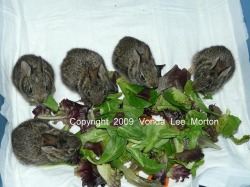
The five "wee wabbits" from the April 1 update have been released...sort of. We attempted a release today and only one adventurous soul left. I was lucky enough to see her leave; the others refused to leave their comfort zone, so we’ll try again tomorrow. Sometimes leaving that endless buffet is difficult...
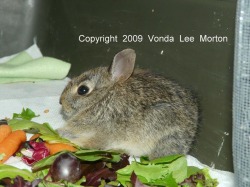
I had one other rabbit come in, cat-attacked, which is generally not a good thing. Cat saliva and, to a slightly lesser extent, dog saliva are highly toxic to their prey. Because there are so few antibiotics that can be used on wild rabbits and because it was after hours for Smalley’s, I called vet Shelley Baumann, who is on maternity leave, for advice: she confirmed that the mild, broad-spectrum antibiotic I keep on hand was suitable for use on this guy, but neither of us really expected him to make it through the night. To my surprise, this little guy did well with a couple of days’ meds and was released!
Folks, as an aside here, if you don’t want to see cat- or dog- attacked wildlife, keep your companion animals inside. They’re gonna do what comes naturally, whether you like it or not, and the best way to keep wildlife safe from domestic animals is to keep your domestics inside–which, by the way, is healthier and safer for them, anyway.
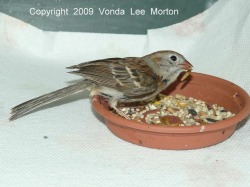
I also had a chipping sparrow (at least, we’re guessing that’s what he is; the pix in the Sibley’s guide left some room for doubt) come in with a slight infection under one wing. He weighed a whopping 10 grams–that’s about a third of an ounce–so medicating him was quite an interesting experience. Vet Peggy Hobby of Smalley’s Animal Hospital suggested, tongue-in-cheek, that we just wave the meds in his general direction and let him inhale the fumes! His appetite was quite good, as you can see, and he responded well to treatment and has been released.
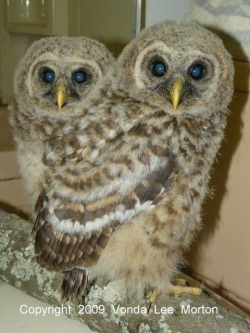
Last Tuesday evening, I also received a 911 call that led to taking in two downy barred owls. "Downy" just means their feathers haven’t fully come in yet. The local paper did a story on this, because it involved the cooperation of several agencies; the link is below.
I also want to again especially thank Laurens County Deputy Matthew Lybrand and Little Ocmulgee EMC lineman Ricky Alligood for going beyond the call of duty in assisting Georgia’s native wildlife.
http://news.mywebpal.com/news_tool_v2.cfm?show=localnews&pnpID=909&NewsID=957429&CategoryID=19667&on=1
I’m not licensed for raptors, of course, so these babies were transferred to Steve Hicks of Bubba & Friends raptor rehab.
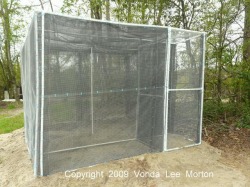
I also promised in the last update to provide some photos of the upgrades at LWR. All these improvements were made possible by a small equipment/repairs grant written by an individual who prefers to remain anonymous. The agency that funded the grant also wishes to remain anonymous, but I want to publicly thank both the individual and the agency, because their help allowed me to vastly improve my facilities.
I mentioned the flight pen previously, and here’s an outside photo. It’s 10x10x7', which is more than double the size of my old flight pen. I have to thank my father here, too, as he helped me construct this avian haven.
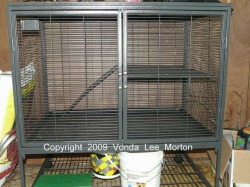
I also was able to purchase possum and squirrel cages which haven’t yet seen use...
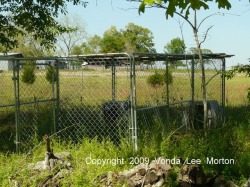
...and double the size of my deer pen.
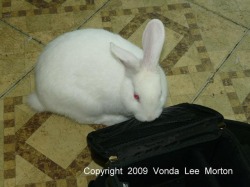
I also have several new crates that will serve, once they’re assembled, as "homes" to pre-fledgling birds, and two rabbit cages, both currently in use. One houses the stubborn rascals who led this update; the other serves as bed, bathroom and dining area to DeWight Rabbit, a working rabbit. (Shh! Don’t tell him that; he’s convinced I obtained him because I needed someone to snoop in every nook and cranny of the rehab area of my house!) DeWight is my new and ongoing source of the gut bacteria that baby rabbits absolutely must have as their eyes begin to open. Domestic rabbits can easily provide this bacteria for wild babies, so DeWight offers the rabbits I take in a better chance at survival just by shedding bacteria–okay, their chances ratchet up from infinitesimal to slim, but that’s still an improvement. How’s that for a twist: I love him for his germs! (It’s a bit more complicated than that, but that’s the gist of his role.)
Another aside here, and a bit of soapboxing: wildlife rehabbers frequently receive praise for their efforts on behalf of our native wildlife, and we appreciate the kudos–really, we do. But the warm fuzzies don’t help any of us feed the animals in our care or pay for the gas we burn driving all over the state to pick up or transfer wildlife. Remember, we don’t get reimbursed by the state or the feds; they’d have to increase your taxes outrageously to pay us for what we do and pay for out of our own pockets. Case in point: last year LWR’s expenses were slightly more than $5000; donations were slightly upwards of $700. Compliments are nice; cash is more useful–it’s also tax deductible for you.
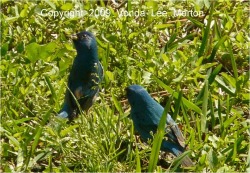
And finally, I offer this photo of two male indigo buntings in my front yard. Indigo buntings are on the decline in Georgia, so I’m always thrilled when I have them grace me with a visit–and on the day I took this photo, I had five of the gorgeous little critters in my yard. If you’ll look closely at their wings, you can see that they’re not quite in total breeding plumage yet–neat, huh?!
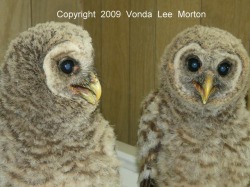
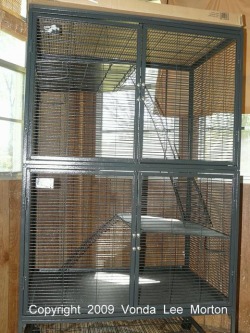
 RSS Feed
RSS Feed
